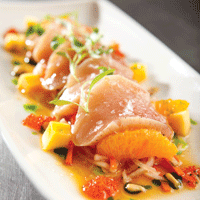The starter course has been part of the dining experience since the Athenians roamed the Earth thousands of years ago. Back then it was served as a buffet is today, with sea urchins, cockles and the bottom-feeding sea fish known as Sturgeon.
The starter was invented as a treat to excite the palate, something to prepare diners for the main event. And, although that tradition remains, yesterday’s deep-fried items have been replaced with today’s lighter, healthier fare; highly caloric dishes are losing favour and leaner ones are gaining ground.
Successful trends include bundling and offering more perceived value through smart cooking with unique ethnic flavours.
So, what’s the big deal with small plates? “An appetizer is part of the ritual of sitting down, dining and taking pleasure at spending time at the table, having a great conversation, being in great company and letting the world stop for awhile,” says Daniel Boulud, chef and owner of a handful of eateries, from New York City to Beijing, and recent guest judge on Top Chef Canada.
Industry experts who specialize in menu planning, cooking and food distribution, agree many apps and small plates are the main event themselves. That’s certainly the case in the centre of the country, at Winnipeg’s Segovia Tapas Bar and Restaurant, where a full dining room is the norm and line–ups are a regular occurrence. Segovia is all about the small-plate experience. “Small plates is all we do; our whole menu is small plates, which is very important to us,” says Adam Donnelly, chef and co-owner. “Our whole concept is come in and try a whole bunch of things. Try six or eight dishes, instead of three.” Socializing amongst friends is crucial to the tapas concept. “Tapas is about small plates and bringing people closer together,” adds Donnelly. “It’s all about sharing and talking about the food together.”
New York’s Boulud, known for innovative food, says the appetizer section is a wonderful place to be creative. “When you create a menu it’s an equation; you create a balance of flavour, ingredients, technique, taste and a balance of temperature in the dishes,” he explains. “It goes from chilled to hot, and in appetizers you can afford to do that. In main courses you don’t really go for cold, most everything is hot.” Small plates allow for many different cooking methods, “you can do things grilled, steamed, poached, fried or seared,” adds the chef.
Sharing is nothing new when it comes to appetizers. We’ve all shared wings, spring rolls or corn chips piled high with toppings. But one idea that promotes customers sharing appetizers, and yields positive results, is bundling (or value offerings). The notion of bundling apps is successful for most operators regardless of their speciality. Whether it’s pairing a combo of small plates with a drink deal or offering a ‘three-for-two’ type of dish, it attracts sales.
Laura Maguire, editorial manager at the Chicago-based Technomic research firm, agrees “bundling is the big thing right now.” According to Technomic’s “2011: The Future of Casual Dining – Canadian Consumer Trend Report,” almost two out of five consumers who patronize traditional casual dining restaurants said they’d be more likely to order an appetizer if it was included in combination meals; the same stat applies to upscale casual-dining spots.
David Evans, corporate chef at the Milton, Ont.-based foodservice distributors, Gordon Food Service (GFS), says the company educates customers to help them incorporate value offerings to build revenue streams. Much like a loss leader stimulates other sales, a value offering encourages guests to choose items to share that they wouldn’t normally choose. It’s a strategy used to bring about the sale of other items, in greater numbers than the loss leader. Whatever name you give it, a smart operator is one who bundles menu items, including appetizers.
Creating a new revenue stream is vital. Scott McDeivitte, senior foodservice advisor at GFS, suggests offering take-away appetizers. He’s found “about 19 per cent of purchases at full-service restaurants are consumed off premise.”
It’s a huge number because “years ago that number didn’t exist. Back then you went to your local QSR or you went to your drivethru.” He sees a large growth opportunity for many, explaining, “appetizers can fit into that, because apps are generally things people wouldn’t make at home.” This potential revenue stream will work as long as you offer customers take-out apps that are a little unusual and transport well.
But, the game changes slightly when it comes to appeasing the health-conscious guest. Technomic’s menu-monitoring program shows that across Canada, traditional greens still top the list on Canadian menus. Soup of the day, Caesar salad, wings and Asian-inspired soups round out the top five. Technomic’s “Future of Casual Dining: Canadian Consumer Trend Report” shows 37 per cent of diners who order at an upscale restaurant choose salad. Asian-inspired soups, — mainly clear broths with small dumplings — noodles or meatballs are perceived by diners as a healthier choice, because they don’t contain cream or large amounts of protein.
|
Top 20 Appetizers |
|
|
1. Garden/House/Side Salad 2. Soup of the Day 3. Ceasar Salad 4. Wings/Chicken Wings 5. Asian Soup 6. Non-breaded Fish 7. Calamari 8. Non-breaded Shrimp 9. Oyster 10. Chicken Strips/Nugget |
11. Chicken/Cheese/Beef Nachos 12. Four+ Item Sampler 13. Garlic Bread 14. Onion Rings 15. Bruschetta 16. French Onion Soup 17. Poutine 18. Cheese 19. Breaded Shrimp 20. Chili |
|
Source: 2011 Menu Monitor, Technomic |
|
In Boulud’s opinion, the very nature of an appetizer list is healthy eating. “There’s many ingredients in the appetizer category you don’t want for a main course,” he says, pointing to caviar, smoked salmon, roe fish, a sashimi or any crudo.
Just a few years ago, many starters, especially at QSR outlets, were fried. Think spring rolls, cheese sticks, crab cakes and tempura-battered shrimp or veggies. Technomic’s Maguire predicts breaded items will continue to fall out of favour. In some markets, such items may already be dropping off menus, as diners search for healthier options, “expect more non-breaded offerings and move away from breaded options.” McDeivitte hints there’s a move toward fresher foods, Korean barbecue flavours, more Asian infused dishes, fish tacos and sushi-inspired choices.
“The biggest trend when dealing with clients is that their customers aren’t looking for the next new thing; they’re looking for an interesting twist on old favourite— gourmet burgers with special extras, pizza with different toppings. That’s what good restaurateurs are doing,” says GFS’s McDeivitte.
In fact, GFS’s Evans says his clients often ask what appetizers he has that aren’t deep fried. His answer? “What about making a cheesecake with gorgonzola, garnished with a fig or some fruit.” You can hear the passion for the process in his voice. “That’s an appetizer. Serve a small slice, not a wedge and you’ve got a savoury cheesecake appetizer.”
But, aside from avoiding deep-fried foods, Technomic’s Maguire knows the food customers are enjoying. For example, flatbreads continue to do brisk business across the board, with lobster items and meaty sliders, either chicken or beef, doing large sales as well. Segovia’s Donnelly prepares scallops with peas and lamb bacon ($11), elk tartare ($14) and baharat-spiced goat leg ($11), to name a few.
Not only is baharat-spiced protein doing well for Donnelly, but ethnic flavour profiles are big for many operators and chefs. Take for example, chef Rob Feenie’s dish, Tuna Tataki ($14), a hot seller at Vancouver’s Cactus Club. “Our Tuna Tataki is one of our top-selling appetizers on a weekly basis, and sales don’t falter very much.” And, no wonder; it’s drizzled with yuzu vinaigrette, Asian citrus fruit, soy, ginger and cilantro as well as other ingredients from dry storage. “It’s just been a complete winner,” echoes Christy Murphy, marketing manager, Cactus Club Restaurants, Vancouver.
“Our signature garlic pan bread ($5.98) is our number-1 selling appetizer,” says SIR Corp’s Graham Hayes, director of Culinary for Jack Astor’s Bar and Grill. However, the Asian influence also serves Jack Astor’s well. Its Shanghai lettuce wraps ($9.97) sell well. “It’s crispy chicken with noodles, hoisin chili-garlic ginger sauce with carrots and cucumbers. We sell quite a few of those.”
Bundling, sharing and infusing an ethnic punch into appetizers works well, but another technique that increases the bottom line and keeps diners smiling, is offering old favourites with a new twist. While the base of the appetizer might be a tried-and- true protein such as chicken or salmon, it takes creativity to skew the item in a fresh way.
Nachos at QSRs have been a staple for many years, but a small change-up can freshen a food concept favourably like it has at Jack Astor’s. SIR Corp’s, Hayes says the company’s twist on tacos is paying off. “Right now we’re featuring fish tacos for the first time, and it’s been really successful. When I looked at the numbers, I was thinking ‘wow, that’s really cool, we sold a lot of those.’”
However, beware of being too creative when giving an ethnic edge to an item. GFS’s Evans reminds chefs that ethnic flavours do work, as long as you stay within the boundaries of the ethnic profile. Successful dishes at restaurants are the meals created with bigger, bolder, flavours that tantalize the palate. Many customers will choose an item, Hayes says, “if it’s unique, ethnic and really different.”
Deconstructing a dish is yet another way chefs can shake things up to give an item fresh appeal. “Not all salads have to be greens with dressing on top,” says Evans, describing his approach to an old standby. “Take gazpacho, when you break it down you’ve got tomatoes, cucumbers, onions, garlic, avocado, spring onions and bread. Now don’t make it into a soup, arrange it on a plate as a salad — like an antipasto — and you’ve got gazpacho salad.”
Moving forward, look for ethnic flavouring to continue to be successful, and look for healthy items to gain strength. And, Technomic’s Maguire believes street cred is in order for forward thinkers. “With the street-food craze doing well in many markets, street-inspired grub is what operators should be menuing in the next 12 months.”
That’s not to say any old ‘street meat’ will do. Maguire suggests chefs consider plating street food-inspired appetizers and small plates such as empanadas, skewers and mini Korean tacos. Her colleague, Darrren Tristano echoes that sentiment in the company’s “Left Side of the Menu Consumer Trend Report.” Due to penny pinching during the recession, he says, “Consumers are trying to cut their budgets, in many cases by eliminating starters. To drive cravings and create interest in appetizers, operators must innovate with exciting dressings and dips, unusual ingredients and preparation techniques that can’t easily be duplicated at home.”
photo courtesy of Cactus Club
More in Feature Articles:
In the Deep: Wading Through the World of Deep Fryers
Straight Shooter: Profiling Chef Neil Taylor
Building an Empire: Profiling Lidia Bastianich
What’s Next for Grant Achatz and Nick Kokonas
A Helping Hand: Ontario Greenbelt Fund Announces New Grants





















